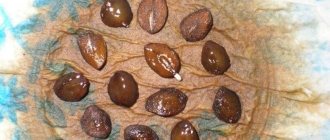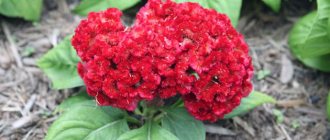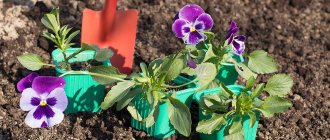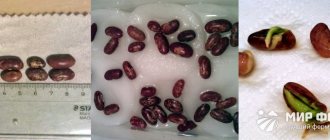When to plant perennial lupins in open ground?
The plant can be planted in the soil after the snow melts and the weather warms up. April best suits these conditions. The area for planting must be cultivated in the fall. With this option, flowering occurs the next year.
It is possible to plant flower seeds in winter. With this option, gardening is best done in October. The sprouts will sprout in the spring, and the lupins will bloom in the summer.
You can plant a plant in various ways:
- Seeds;
- Seedlings;
- By cuttings.
The areas for lupins are chosen to be bright and spacious. Hills suit them well.
Features of growing lupins from seeds
Lupine is a very beautiful flower and is well known among gardeners and landscape designers. The plant is interesting not only from the point of view of its decorative properties. For example, it is known for certain that the ancient Romans and Greeks used it both as the main feed for livestock and as a medicine with which many diseases were cured.
Today, lupins can be seen in personal plots, as well as in parks and gardens, where the flower stands out effectively against the background of other garden greenery and is often the central element of flower arrangements. Due to the high popularity of the plant, the issue of its seed propagation is quite relevant for both professional gardeners and amateur gardeners.
Planting seeds in open ground
Work on planting flowers is traditionally carried out in autumn or spring.
In October or April, sowing takes place in open ground. The distance between future plants should be from 30 to 50 cm. The holes are made at a depth of 3-4 cm if the soil is sandy, or 2-3 cm if it is heavy. Seed sprouts appear as soon as the soil warms up to 3 degrees. Plant seedlings can withstand short frosts down to -4 Co. With this planting method, lupins will begin to bloom next year.
When sown in autumn, the plants will show themselves in all their glory in the summer. The seeds will not have time to germinate before winter, but will ripen well in the cold season. In autumn, lupins should be planted to a depth of 2 cm and sprinkled (mulched) with peat on top. There is no need to water them.
Growing seedlings
The seedling method requires preparation. It is necessary to make a soil mixture of one share of peat, one share of turf soil and half a share of sand. Before sowing, the seeds can be mixed with crushed root parts of old flowers to promote faster growth of nitrogen-absorbing bacteria. After a couple of weeks, seedlings appear.
Please note that when planting lupins as seedlings or sowing seeds, the flowers that grow are predominantly purple or pink, and the white color most likely will not show itself.
As soon as the plant has formed 5-6 leaves, it needs to be moved to open ground, since it has a tap root system and takes root less well if planted later. Before planting, the soil is loosened and, if desired, fertilized with organic matter. The distance between seedling bushes is 30-50 cm.
Propagation by cuttings
Another suitable method for propagating lupins is vegetative. It is this that allows you to preserve the color scheme of the plant. Bushes that are 3-4 years old are excellent for this purpose, since those that are older have too long roots and no longer form young buds.
In the spring, the basal rosette that appears at the base of the stem is cut out from the lupine variety you like. In the summer (after flowering), lateral shoots formed in the axils of the leaves are suitable for cuttings. The roots of new plants planted in sandy soil somewhere in the shade appear by the end of the first month. After this, the lupine is transplanted to a permanent place and it can bloom in the first year.
How to properly process seeds
In order for the seed to germinate better and for the seedlings to be uniform and grow evenly, it is necessary to pre-soak the flower seeds for several days. You can do without soaking, but in this case germination will not be friendly and simultaneous. You need to take gauze, moisten it with warm water, then sprinkle on half of it the amount of seeds required for planting, and then cover with a free piece of gauze. It is better to put the soaked seed on a dish and place it in a warm place. Here, each seed will quickly germinate, and when small sprouts appear, you can sow it in the ground.
Before sowing, it will be very good to mix the seeds with crushed roots of tubers of old lupins; this will allow young shoots to quickly develop and take root.
Proper care of perennial lupins
Plants provide beautiful flowers of various shades if they are taken care of.
Soil and lighting requirements
The soil for lupins should be loose and fresh.
Plants in general are not demanding, but they feel great in this soil:
- Slightly alkaline loam or sandy loam;
- Slightly acidic.
When the soil is very acidic, lupins become weak, pale, and stop blooming. If there is an excess of alkali in the soil, the plant begins to hurt. To avoid this, water the ground with a weak acid solution or mix in peat (5 kg per 1 m2).
There should be enough lighting for the flowers. It is recommended to plant lupins in bright sunny areas. It is best to choose the southwest side for plants with a light openwork shadow from the trees. With this placement, the flowers do not get sunburned during the summer heat.
Lupine - beautiful candles
You can’t help but be surprised when you drive along country roads in summer. Long candles of lupine stretched from end to end, turning abandoned meadows into a lilac-blue ocean. Who raised such beauty? The lupine miracle of nature is that for dense thickets of a flower, all it takes is for one seed to accidentally fall and be picked up by the wind. Even barren sandstones can be sown with lupine, because its root system is highly branched and can extract useful substances from the deepest layers of the soil.
Lupine © sakichin
The presence of nodule bacteria on the roots, which are capable of fixing free nitrogen and thereby enriching the soil, has made lupine a very valuable agricultural crop - green manure. Therefore, agronomist breeders also paid attention to lupine, but for them the variety of flower colors was only an additional effect of the created varieties. Flower growers value this plant precisely for its huge range of colored inflorescences and for its resistance to any growing conditions.
Content:
Diseases and pests
During the formation of buds, aphids may settle on the bushes. At a later time, the lupine can be damaged by the nodule weevil or the larvae of the germ fly. In order to get rid of them, you will have to treat the bushes with an insecticidal solution.
The greatest danger of all diseases for crops are: fusarium wilt, mosaic, rust, rot (root and gray), spotting and phomopsis.
For prevention purposes, it is imperative to follow the rules of agricultural technology. Pay special attention to the rules of crop rotation; in the area where lupine grew, it can only be grown again after 3 years. It will grow best where cereals were previously grown.
Rules for caring for lupine
The rules for caring for lupine are very simple: plant it, sometimes water it, and trim it in time. Sometimes in the spring a small amount of mineral fertilizer is applied under the bush.
Lupine grows well in any soil and can grow for up to 6 years in one place. It is recommended to replant specimens of collection varieties once every 4 years. In a temperate climate, when it rains once a week, no additional watering is required (the leaves of the plant are drooping and are able to collect dew). After sunset on hot days, the plant will not refuse a cool shower.
Lupine can easily withstand frosts down to -8 °C. Therefore, in our conditions, it is enough to cut the perennial lupine bushes short for the winter, and it is not necessary to cover them with anything.
The first flower “candle” appears in mid-May. If you prune it before it dries completely, the lupine will bloom again at the end of August. Dried leaves inhibit the formation of flower buds and need to be pruned. For an overgrown and large bush, you may need support - a metal or wicker hoop tied to the central rod, otherwise long stems with beautiful flowers will end up on the ground.
Lupine © ch.deff
Types and varieties of lupins with photos and names
Below we will describe those types of lupine that are most widely known.
Lupine angustifolia, or blue
The height of such a herbaceous plant varies from 0.8 to 1.5 meters. The surface of its erect shoots has sparse pubescence. There is also pubescence on the underside of the palmately divided leaf plates. Fragranceless flowers can be colored pink, white or purple (for some reason it was considered blue, which is why the species was called “blue lupine”).
Lupine multileaf
In nature, this species is found in the northwestern part of North America. It is highly frost-resistant, which is why it grows well in mid-latitudes. The height of the bush varies from 0.8 to 1.2 meters.
Straight shoots are almost naked. There is pubescence on the underside of the long-petioled palmate leaf blades. The length of the inflorescence is from 0.3 to 0.35 m, they contain a large number of blue flowers. Blooms in June, flowering duration is about 20 days. If you pick off the inflorescences that have begun to fade in time, then in the last summer weeks the bushes will bloom again.
Lupine yellow
This annual plant has pubescence on the surface of the sparsely leafed stem. On long petioles there are pubescent leaf plates, which contain from 5 to 9 blades. The whorled racemose inflorescence consists of yellow flowers, the smell of which is very similar to mignonette.
Caring for lupine in autumn, preparing for winter
The disadvantage of this situation is the presence of toxic alkaloids in the plant.
For feeding animals, only yellow or white lupins should be used - they contain the least amount of toxic substances.
The blue species cannot be used as a forage crop. Usually the green part of the plant is used for feed mixed with other ingredients: silage, dung, artificial feed.
To prepare fodder and hay, the plant is cut at the stage of bud formation. Yellow lupine is mowed before the onset of the bean formation phase, white - without waiting for the end of its flowering.
In field
Perennial lupins - planting and care
This is a truly unpretentious plant that does not require any special growing technology. The most important thing is to know what kind of soil lupine prefers, as well as the period for planting it.
This flower feels equally good in shady or sunny places. If you want to achieve the highest levels of decorativeness, then place it in a shaded area of the site.
It loves slightly alkaline, non-acidic soil; with high acidity it will grow very frail, and in alkaline soils it can develop chlorosis. This situation can be changed if you first add dolomite flour (or lime acid) to the soil.
Perennial lupine is sown after the snow melts, around April. The plot of land on which the flowers will grow should be prepared in the fall. Before sowing, it is recommended to treat the seeds with foundationazole (50% solution). With this approach, you will be able to see the first flowers after 12-13 months (they usually bloom by May).
Seeds (beans), photo:
To obtain lupine seeds, several pods should be left on the plant, which will dry, ripen and provide the necessary seed material. During flowering, faded inflorescences are usually removed - this is necessary so that the growth of new flowers is not inhibited and self-seeding does not occur.
Leave a few inflorescences until they ripen completely (preferably in August); if you don’t have lupins yet, you can always buy the seeds at flower shops. The pod must be completely dry (no moisture allowed), and the extracted beans should also be thoroughly dried. It is best to store seed material in a glass container or in fabric or paper bags.
Lupine propagation - different options
If you are going to plant these flowers in your dacha, then know that annual lupine can only be propagated using seeds. Perennial species are available for propagation by seeds and cuttings.
Propagation of perennial lupine by cuttings
A cutting is a growth bud that is located on a rosette of leaves at the base of the plant. With the arrival of spring, these buds are carefully cut off and then rooted in open ground (choose a shaded area). At the planting site, it is very advisable to dilute the soil with sand to make it lighter. Another option is to select young shoots from the leaf axils after the plant has already flowered.
This planting source is rooted in the soil in the same way; the process of adaptation and establishment of the plant in a new place lasts approximately 35-40 days. After this time, the rooted seedlings can be transferred to flower beds, alpine hills, and flower beds. The main thing is not to exceed the recommended period so that the plant does not have time to take root thoroughly and take root. Lupine roots react extremely negatively to any intervention, so replanting will not lead to anything good. For the same reason, this flower is not propagated by dividing the bush.
Lupins from seeds - growing
First of all, you need to decide on the sowing time: it can be autumn or spring. Frost-resistant, self-seeding representatives of this crop are preferably planted in the fall. Around November, when the first frosts have already occurred, the seeds are buried a little (about 2-3 cm) into the soil and covered with a thin layer of peat. The distance between future bushes should be approximately 15 cm. Thus, with the arrival of spring you will see young growth, and by the end of summer it will give color. If you decide to plant plants in the spring, then choose the first weeks of April. Then, with the arrival of next spring, you will be able to admire the diversity of these beautiful flowers.
Interesting Facts
- Lupine is a green manure that enriches the soil with microelements .
- The plant is also grown as fodder - an excellent food additive for pets.
- The plant has its second name “Wolf Beans”.
- If you squeeze oil out of Lupine, its composition will be close to olive oil.
- In America, Perennial seeds are used for food after they have been pickled.
- One hectare of the sown Lupine plant can easily replace 36 tons of manure spread over this hectare to fertilize the depleted soil.
- Lupine is used not only in landscape designs, but also in medicine. It is also used to make fish food .
This flower is very unpretentious and deserves to have a place in the flowerbed. Its beautiful candle flowers with a variety of colors and leaves reminiscent of palm leaves will be a wonderful decoration for your garden.
The plant often decorates gardens and homestead areas.
Read also: Corn planting and care in open ground in Siberia
For lovers of landscape design, we often write about the use of plants in garden decoration. Although Lupine is not included in this list, we recommend reading which plants are suitable for creating spring flower beds.
All parts of the plant cut in the fall must be embedded in the soil, and they will noticeably improve its chemical composition, since during the summer period the roots of perennial Lupine accumulate a lot of nitrogen.
How to care for lupine
In the first year of life, a standard set of “services” is sufficient for this plant - watering, loosening, and weed removal. From the second year, supplement the care with phosphorus-potassium fertilizers, which should be applied before the start of the flowering phase. If the flowers are long enough, install pegs and tie them up. As mentioned above, dry inflorescences should be removed in a timely manner.
In autumn, all dried fragments of the plant are cut off, and the area around the flower is mulched with suitable material that does not change the pH of the soil. For this purpose, mulch of inorganic origin is often used. Those varieties that do not tolerate frost well (low frost resistance) should be additionally covered with protection (covering fabric). During development and growth, the flower's root collar may become exposed; if this happens, it should be spudded (covered with a layer of soil). After 4 or 5 years, the plant exhausts its resources, grows old, then the time comes to replace it with a young representative, and everything starts all over again.
Care after flowering
What time to collect seeds
After full ripening, the lupine bean cracks and seeds fly out of it in different directions. In order to have time to collect them before they fall asleep, it is recommended to cut the fruits as soon as they turn yellow and begin to dry. You will have to cut several times until you get the desired number of beans.
See also: Planting pepper seedlings in the Urals in 2021: timing, favorable days
How to care after flowering
After flowering ends, in the first days of October, the foliage and peduncles are pruned, and seeds are collected, if necessary. Perennials will need hilling, which will help cover the root collar with soil if it is exposed. Then the surface of the area is covered with a thick layer of sawdust so that the flowers do not freeze in winter.











